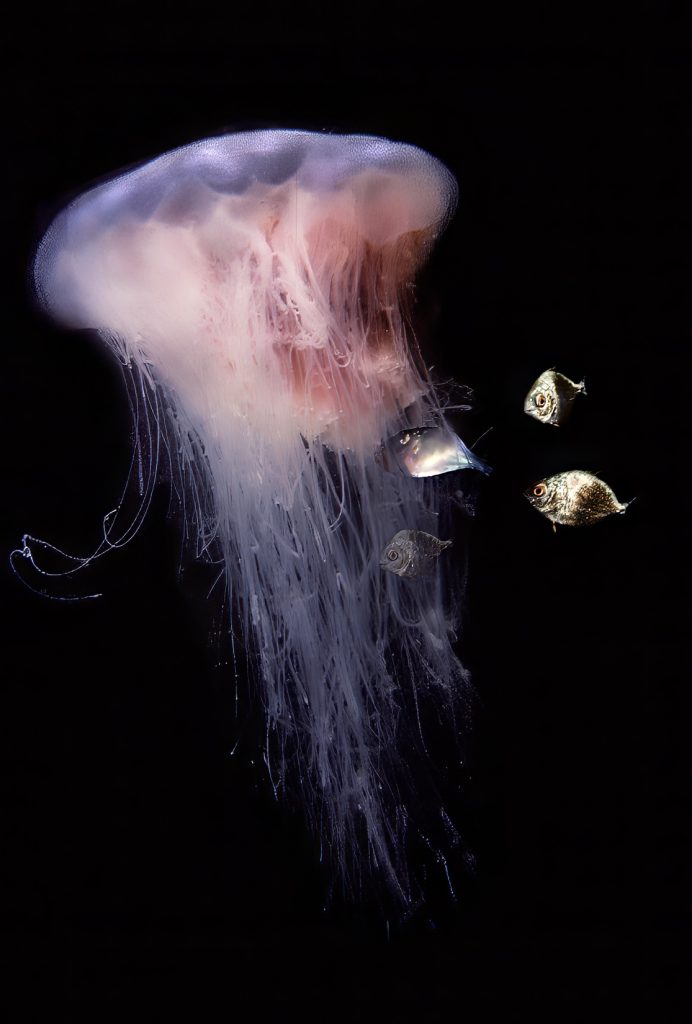A calm Long Island Sound and a midday sun can reveal an attractive sight, just a few feet below the surface. As it pulses its bell and drifts in the currents, it is occasionally accompanied by several small, slate-blue colored butterfish. They closely follow the lion’s mane jellyfish (Cyanea capillata), swimming unharmed among its stinging-cell armed tentacles. The jellyfish provides them access to food among its tentacles and refuge from their predators.
It is one of the prettiest and graceful sights of the Sound’s many marine animals. However, as attractive as it can be, the “beauty is also a beast.” Swimmers that come into contact with the jellyfish and beachgoers that touch a beach-stranded lion’s mane tentacles can be stung.

The injury is usually mildly painful, often described as more of a burning sensation rather than a sting. The site of contact usually develops redness and a rash with some swelling. But more sensitive individuals may develop nausea, sweating, muscle cramps or difficulty breathing. However, those symptoms are very rare. There are no recorded mortalities from its sting in the medical literature. But in an Arthur Conan Doyle mystery, Sherlock Holmes encounters a man who emerges from nearby seawater, staggering like a drunk. He drops to the ground and moans the words “Lion’s Mane.” Moments later, he passes away. In the story, Holmes ultimately concludes that the “murderer” was the jellyfish!
First aid for a lion’s mane sting and other jellyfish encountered in Long Island Sound, includes washing the area with household vinegar. Soaking the area with hot water (110 to 113 F) for 20 to 30 minutes is also recommended. However, do not scrub off the tentacles. Instead, use tweezers or a gloved hand to remove them. Peeing on them immediately discharges the stinging cells as does applying alcohol, meat tenderizer or rinsing with cool fresh water. Applying 0.5% to 1% hydrocortisone cream helps heal the rash.
Lion’s mane jellyfish inhabit the Atlantic, from Florida to the Arctic and in the Pacific, from Alaska to southern California. They are also common to the cold northern European waters. In the Sound, the jellyfish’s bell is about 10-12 inches in diameter with tentacles that can exceed 2-3 feet in length. The more southerly lion’s mane is smaller, while those in Artic waters can have 100-feet tentacles. Their record length has been measured at 120-feet – not one to fool with! They are the world’s largest jellyfish.
Worldwide, there are an estimated 2,000+ species of jellyfish. In the Long Island Sound region, there are two sub-species of the lion’s mane. One develops and generally remains within the Niantic River estuary, while the other inhabits the open Sound. The second one is especially common to its waters during the summer, though it can also be found in the spring and winter. Moon jellyfish (Aurelia aurita), another common species to the general Sound, make their appearance during late spring. The creatures are easily recognized by the four horseshoe shapes seen through the top of their transparent bell. Though they are equipped with hundreds of short, delicate tentacles, their sting has no effect on humans.
Atlantic sea nettles (Chrysaora quinquecirrha) are yet another species of jellyfish that reside in the Sound, mainly during the summer months. They range from the Gulf of Mexico, the Caribbean and north to Cape Cod. By far, their greatest population is in Chesapeake Bay’s less saline sites (estuaries) and middle bay. Long Island Sound’s waters are also favorable to them. Their sting is regarded as annoying but not lethal to humans unless that person is allergic to their venom. Like other species of jellyfish, the sea nettle is a carnivore, feeding on small fish and tiny crustaceans. One of their favorite preys is said to be the comb jelly called sea walnut (Mnemiopsis leidyi).
Jellyfish belong to a specific group of marine animals (phylum Cnidaria), that include corals, anemones and hydroids. Comb jellies are not related to jellyfish. They belong to an entirely different phylum (Ctenophores). Also called the common southern comb jelly, sea walnuts are generally 2 to 3 inches in length. Like other comb jellies, they are not equipped with stinging cells; they do not sting. As they swim using rows of beating combs, they are captivating and interesting. Sea walnuts and many others of their like species produce a biological light (bioluminescence). Worldwide, there are an estimated 50 to 186 species of comb jellies living in nearly all of the oceans.
The beauty of marine life can be experienced through their images or an aquarium’s glass. Snorkeling and better still scuba diving, allows the viewer to more closely examine and appreciate their hidden structures and elegance. However, all of the stinging varieties must be admired at a distance.
